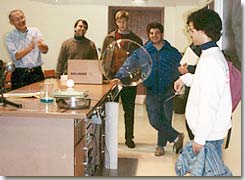Charles Holbrow
Throughout his career, nuclear physicist Charlie Holbrow has oscillated between physics and history.
Holbrow's first memory of his interest in physics comes from when he was about 13 years old. He saved up money from his paper route to buy a copy of Millikan's Electrons (+ and –), Protons, Photons, Neutrons, Mesotrons, and Cosmic Rays. “I read about two pages, and it made no sense to me whatsoever,” he recalls. “But I still have the book, and now it makes lots of sense.”
 Charles Holbrow with a group of students.
Charles Holbrow with a group of students.In 1951, at age 15, Holbrow entered college at the University of Wisconsin, Madison, intending to major in physics. “I think I was inspired partly by the post-nuclear glow,” he says.
Then he changed his mind. Like many potential physics majors, he found the subject too hard. “I didn't do very well at it, which I didn't mind because there were a lot of things I didn't do very well at. What I didn't like was to work really hard and not do well.”
He decided to major in history instead and went on to graduate school in history at Columbia where he got an A.M. degree and completed all the requirements for a PhD except the dissertation.
“But I always liked math, and after a couple of years I began taking time from studying for my history PhD exams to sit in on an advanced calculus class. Then sputnik went up, and I decided to go back to physics.”
So in 1957 he returned to Madison, Wisconsin, where he earned his physics PhD in 1963. After three years teaching at Haverford College, two years at the University of Pennsylvania, and a stint as an editor at the magazine Physics Today , he headed to Hamilton, New York to become a physics professor at Colgate University, where he remained for 36 years until his retirement last year.
In 1975-76 he spent a sabbatical year at Caltech, working in the Kellogg Radiation Laboratory. A few years later he revisited Caltech briefly and took up history again. After several intensive weeks in Caltech's archives, he wrote a short history of the Kellogg lab.
Back at Colgate, he continued his nuclear physics research. In the 1980's, he studied the properties of unstable ytterbium atoms produced in a particle accelerator. More recently, in 1994, at GSI, the heavy ion research facility in Darmstadt, Germany, he worked with colleagues to produce and study lead ions with all but one of their electrons stripped off, making them hydrogen-like. Because the one electron zooms around in an intense electric field produced by lead's 82 protons, the ions are a good laboratory to study interesting relativistic effects, says Holbrow.
In addition to physics and history, Holbrow is interested in pedagogy. For the past year he has served as president of the American Association of Physics Teachers. In the mid 1990's, he and colleagues at Colgate “turned the introductory physics sequence on its head,” by teaching students modern physics first, before mechanics and electromagnetism. Holbrow credits this and other changes with fostering at Colgate one of the more successful physics programs “at a time when a whole lot of people were bemoaning the decline of their programs.”
Last July, after 36 years, Holbrow retired from Colgate. “At some point you ask yourself ‘what can an old physicist do that's amusing and doesn't require him to stay up all night in the laboratory?'”
For Holbrow, the answer was clearly history, so he is currently spending his time in the archives at MIT, researching an episode in the life of Charlie Lauritsen, a Caltech nuclear physicist and government advisor who was involved in major decisions on American defense policy after WWII.
Though he never met Lauritsen, who died in 1968, Holbrow feels he has become friends with him. “He was publicly a very somber person, but it's clear from how his friends write about him that he was amusing and charming and affectionate,” says Holbrow. Although Holbrow admits that “You'd like him to have been a little more flamboyant to make good copy,” he has recently published an article on Lauritsen in the journal Physics in Perspective , and is seriously considering writing a full-length biography. “The more I learn about this man, the more I admire him,” says Holbrow.











